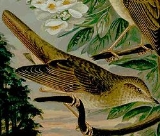
Thrush Nightingale
Encyclopedia
The Thrush Nightingale, Luscinia luscinia (formerly colloquially known as Sprosser), is a small passerine
bird
that was formerly classed as a member of the thrush
family Turdidae, but is now more generally considered to be an Old World flycatcher
, Muscicapidae. It, and similar small Europe
an species, are often called chats
.
It is a migratory
insectivorous species breeding in forest in Europe
and Asia
. The distribution is more northerly than the very closely related Nightingale
, Luscinia megarhynchos. It nests low in dense bushes. It winters in Africa
.
The Thrush Nightingale is similar in size to the European Robin
. It is plain grey brown above and grey to white below. Its greyer tones, giving a cloudy appearance to the underside, and lack of the Nightingale's obvious red tail side patches are the clearest plumage differences from that species. Sexes are similar.
The male's is loud, with range of whistles, trills and clicks. It does not have the Nightingale's loud whistling crescendo.
Passerine
A passerine is a bird of the order Passeriformes, which includes more than half of all bird species. Sometimes known as perching birds or, less accurately, as songbirds, the passerines form one of the most diverse terrestrial vertebrate orders: with over 5,000 identified species, it has roughly...
bird
Bird
Birds are feathered, winged, bipedal, endothermic , egg-laying, vertebrate animals. Around 10,000 living species and 188 families makes them the most speciose class of tetrapod vertebrates. They inhabit ecosystems across the globe, from the Arctic to the Antarctic. Extant birds range in size from...
that was formerly classed as a member of the thrush
Thrush (bird)
The thrushes, family Turdidae, are a group of passerine birds that occur worldwide.-Characteristics:Thrushes are plump, soft-plumaged, small to medium-sized birds, inhabiting wooded areas, and often feed on the ground or eat small fruit. The smallest thrush may be the Forest Rock-thrush, at and...
family Turdidae, but is now more generally considered to be an Old World flycatcher
Old World flycatcher
The Old World flycatcher family Muscicapidae is a large family of small passerine birds mostly restricted to the Old World. These are mainly small arboreal insectivores, many of which, as the name implies, take their prey on the wing.-Characteristics:...
, Muscicapidae. It, and similar small Europe
Europe
Europe is, by convention, one of the world's seven continents. Comprising the westernmost peninsula of Eurasia, Europe is generally 'divided' from Asia to its east by the watershed divides of the Ural and Caucasus Mountains, the Ural River, the Caspian and Black Seas, and the waterways connecting...
an species, are often called chats
Chat (bird)
Chats are a group of small Old World insectivorous birds formerly classed as members of the thrush family Turdidae, but now considered Old World flycatchers....
.
It is a migratory
Bird migration
Bird migration is the regular seasonal journey undertaken by many species of birds. Bird movements include those made in response to changes in food availability, habitat or weather. Sometimes, journeys are not termed "true migration" because they are irregular or in only one direction...
insectivorous species breeding in forest in Europe
Europe
Europe is, by convention, one of the world's seven continents. Comprising the westernmost peninsula of Eurasia, Europe is generally 'divided' from Asia to its east by the watershed divides of the Ural and Caucasus Mountains, the Ural River, the Caspian and Black Seas, and the waterways connecting...
and Asia
Asia
Asia is the world's largest and most populous continent, located primarily in the eastern and northern hemispheres. It covers 8.7% of the Earth's total surface area and with approximately 3.879 billion people, it hosts 60% of the world's current human population...
. The distribution is more northerly than the very closely related Nightingale
Nightingale
The Nightingale , also known as Rufous and Common Nightingale, is a small passerine bird that was formerly classed as a member of the thrush family Turdidae, but is now more generally considered to be an Old World flycatcher, Muscicapidae...
, Luscinia megarhynchos. It nests low in dense bushes. It winters in Africa
Africa
Africa is the world's second largest and second most populous continent, after Asia. At about 30.2 million km² including adjacent islands, it covers 6% of the Earth's total surface area and 20.4% of the total land area...
.
The Thrush Nightingale is similar in size to the European Robin
European Robin
The European Robin , most commonly known in Anglophone Europe simply as the Robin, is a small insectivorous passerine bird that was formerly classed as a member of the thrush family , but is now considered to be an Old World flycatcher...
. It is plain grey brown above and grey to white below. Its greyer tones, giving a cloudy appearance to the underside, and lack of the Nightingale's obvious red tail side patches are the clearest plumage differences from that species. Sexes are similar.
The male's is loud, with range of whistles, trills and clicks. It does not have the Nightingale's loud whistling crescendo.

